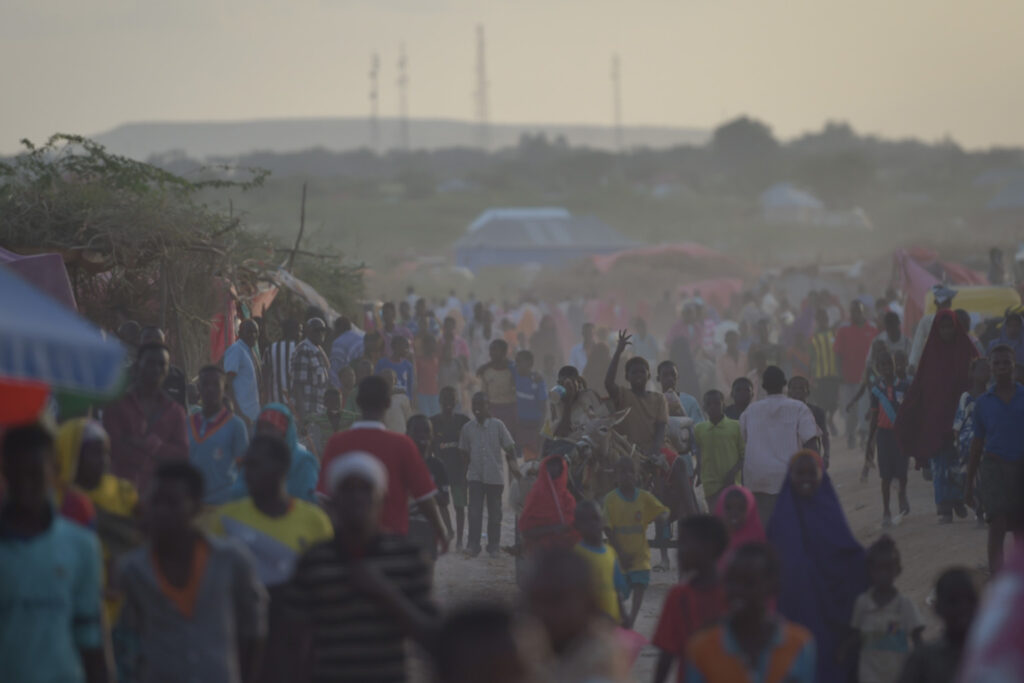The United Nations Climate Change Conference (COP27) last fall focused the world’s attention on the many climate-related crises to come, including floods and droughts; inhospitable heat; saltwater intrusion and inundation; the loss of biodiversity; the loss of agricultural regions; and more violent storms. But one of the greatest impacts of climate change—human migration and the political, social, and cultural dislocations it will cause—was not even on the agenda.
Human migration, much of it caused by climate change, will threaten the identities and cultures of many countries to which migrants will attempt to move. A bold plan is needed to manage the challenges both departure and destination countries will be facing in the years to come. Some have made the case refugees and displaced persons need to have a seat at the table at the upcoming COP28 in Dubai. The projected impact of climate on internal and transboundary human migration merits inclusion on its agenda.
The scale of human migration over the next several decades will be unprecedented. In a March 2018 report, scientists at the Intergovernmental Science-Policy Platform on Biodiversity and Ecosystem Services estimated that environmental degradation alone will occasion the migration of as many as 700 million people by 2050. A 2020 report issued by the Institute for Economics & Peace concludes that if the current rate of displacement continues, “1.2 billion people could be displaced globally by 2050.” This is one out of every seven people on earth. The report projects at least one in five of these displaced people will move beyond their own country or region. The world is not ready to deal with the human, financial, social, cultural, and political consequences of this situation.
“Destination countries,” to which migrants around the world will be trying to move, especially those with low total fertility rates, are facing the prospect of losing their historic national identities. Whether this is a good or bad thing in the abstract is debatable. Nevertheless, it almost certainly will be unacceptable to a large percentage of their citizens in part due to economic and other fears. Few destination countries are multi-cultural or pluralistic societies, and thus are poorly positioned to absorb and assimilate outsiders. For this reason, those who have migrated to such countries in the past often have faced prejudice, discrimination, segregation, and physical conflict. As the number of migrants increases, the resistance to their arrival will only grow. Indeed, the prospect of increased migration has given rise to right-wing, autocratic, anti-immigrant movements in many destination countries.
Nascent efforts to manage the challenge of human migration include the United Nations’ adoption of the New York Declaration for Refugees and Migrants in 2016. Recognizing migration ranks as one of the greatest impediments to the realization of the Sustainable Development Goals, member states agreed to implement effective migration policies, such as sharing the burden to host, support, and protect refugees. To this end, the UN subsequently endorsed a Global Compact for Migration calling for the development of evidence-based migration policy, mitigation of climate related impacts where they occur, and the protection of migrants. In doing so, it reaffirmed the principles of national sovereignty. The Trump Administration did not endorse the Compact, but the Biden Administration reversed course and did so, albeit with qualifications. The University Network for Human Rights and others have argued there is a need to expand climate immigration.
But expanding immigration will be insufficient to manage the challenge. The projected number of migrants simply will be too great to absorb. What will happen is unclear. Many leaders of destination countries will respond by enhancing barriers and interdicting and incarcerating migrants. Such actions will be designed not only to stop people from entering, but also to discourage others from trying. But whatever success these efforts have had in the past, they are unlikely to manage effectively the human deluge to come, even if they become harsher. The moral, political, cultural, social, and economic impact of their responses will test their people and the countries if they are successful or not.
The opposition to human migration is founded on the historic importance given to sovereignty and the historical need to control and defend national borders. Sovereignty provided the structure and national identity needed for countries to defend their borders during a time when their defense was sufficient to keep people safe. But what happens when physical borders no longer can do so? In such a situation, the notion of sovereignty is likely to fail at keeping its most essential promises, including sustaining the organizing principles of nation states and their national identities.
What can be done? The world needs a plan. It would need to have three pillars:
- The flow of migrants needs to be delayed and slowed whenever and wherever possible;
- There must be an organized, ongoing process by which some migrants are allowed to resettle in other countries;
- Destination countries need to play a role in receiving migrants on both a temporary and permanent basis.
These pillars would be both achievable and affordable if the below actions were to be taken now:
Slowing Migration to Destination Countries
Steps must be taken to make it possible for people to stay in their homes until conflict, climate change, or other natural forces make it impossible for them to do so. Some of the costs of making this possible would be used to mitigate the reasons for migration, such as those associated with climate change. Other costs would include providing basics such as food, water, and housing. The objective would be to make it possible for the maximum number of people to remain in their homes for the maximum amount of time.
One way to evaluate the cost of accomplishing this objective would be to focus on the projected price tag associated with achieving the SDGs, which economists at the United Nations have estimated to be between USD 5.4 and 6.4 trillion per year between now and 2030. Raising these funds and allocating them productively will be a massive challenge, made even more problematic because of the need to “triage” communities to determine whether the expenditures would make a difference—and if so, for how long. Donor countries providing the funds would rightfully want to have a deciding role in where and how their money will be spent. But the process would be politically fraught, likely leading to unrest in nations or populations where funds are not allocated.
The allocation of funds needed to allow people to remain in place would be difficult for another reason. Leaders of many countries are failing to provide basic services to their people due to corruption, malfeasance, and mismanagement. These corrosive behind the border problems are causing problems beyond the borders where they are occurring. Under such circumstances, the potential destination countries should require leaders to take prescribed actions on behalf of their people in order to receive funding. For further encouragement, donor countries could restrict foreign aid, prevent foreign direct investment, utilize economic sanctions, and impair the operations of tax havens. Said simply, directing the allocation of funds provided to countries contributing to the flow of migrants should be seen as justified for the stability of destination countries and the preservation of the global order.
Relocating Migrants
It will not always be possible for people to stay at home. A plan for relocating them needs to be in place long before their migration is required, in part to manage expectations and make the move less traumatic. For this reason, a formal re-location program should be designed, communicated, implemented, and administered when needed. A program designed along the lines of the Global Migrant Compact or one structured as a standalone organization comprised only of countries prepared to accept migrants are two possibilities. But in either case, receiving countries will need to be identified and make a formal commitment to participate in the program. The goal would be for the program to allocate migrants on a fair and equitable basis and train them to be ready to live in their new homes.
The program’s intake process would assess the ability of specific countries to accept migrants and in what numbers; keep families together; match migrants with various skills with needs of host countries; conduct a needs assessment to determine what financial resources are required for the re-located migrants; and determine what the migrants need to prepare them for their new homes. Constituting an international fund to provide such support would make it possible for more countries to participate in the program.
Establishing a Federation of New Nations
It is unlikely a voluntary immigration program would be sufficient to manage the flood of migrants that currently is being projected. Something else will be needed. One possibility is a network of interrelated, interconnected, autonomous, and self-governing regions or countries–a Federation of New Nations (“FNN”). The details of such an FNN network would need to be researched and developed. But the following offers an example of how it might be designed:
- Suitable territories (inhabited and uninhabited) would need to be identified and ceded outright or leased, either with or without compensation from the countries which have sovereignty over them;
- The ceding countries would transfer sovereignty; in the case of those leasing territory, it could do so only for a specified term;
- Compensation for the territories could come from sovereign funds, private foundations, financial institutions, other investors, and/or taxes on the future economic activity in the areas created;
- Commercial opportunities could be designed to favor the ceding states, thereby increasing the economic benefits they would derive from the sale or lease of their territories.
The FNN member states would need to have certain characteristics to accomplish the goal of providing an alternative destination for migrants. Included among them would be well-defined and secure borders; a formal intake process; recognized legal status, allowing those living in them to apply for visas; self-governance limited only by the obligations of each member to protect all of its citizens and participate in a commonwealth comprised of other FNN members; a legal system; housing; healthcare facilities; schools; a well-trained police force composed of residents; job training; an economic development office; employment opportunities; public transportation; a tax system; free trade agreements with other members; unrestricted travel among the states; and the ability to apply to the World Bank, the IMF, and others for loans. Said simply, they each would need to function as a nation state functions.
Some will argue the establishment and operation of an FNN is fanciful given the current role of sovereignty in the world. But reflexive assertions of sovereignty will prove to be meaningless if they lead to the loss of a country’s culture and identity. It is far better to cede some territory, perhaps even profiting by doing so, to preserve sovereignty’s primary virtues. And for those who argue the world cannot afford to fund the mitigation and maintenance efforts to keep populations in place, and the creation and operation of an FNN, the number of migrants make clear that what truly is unaffordable would be to do nothing.
The lesson of American mountain climber Aron Lee Ralston is instructive in evaluating the proposal to establish an FNN. In 2003, a boulder Ralston dislodged while climbing pinned him to the side of a canyon wall. After five days without assistance, he broke his forearm in order to self-amputate it with a pocketknife. He then rappelled down a 65-foot rock face and walked seven miles to safety. Ralston’s story illustrates the lengths to which some individuals have gone to survive. His is a story that nations would do well to keep in mind as they struggle to preserve their national identities in the face of the human migration to come.
References
Reva Dhingra and Elizabeth Ferris, “COP27: An Opportunity to Get Serious About Climate Migration,” The Brookings Institution, November 1, 2022, https://www.brookings.edu/articles/cop27-an-opportunity-to-get-serious-about-climate-migration/.
UNHCR, “UNHCR: Refugees and Displaced People Need Seats at COP28 Table,” November 18, 2022, https://www.unhcr.org/news/briefing-notes/unhcr-refugees-and-displaced-people-need-seats-cop28-table.
IPBES, “Media Release: Worsening Worldwide Land Degradation Now ‘Critical’, Undermining Well-Being of 3.2 Billion People,” March 23, 2018, https://www.ipbes.net/news/media-release-worsening-worldwide-land-degradation-now-%e2%80%98critical%e2%80%99-undermining-well-being-32.
Institute for Economics & Peace, “Ecological Threat Register 2020: Understanding Ecological Threats, Resilience and Peace (Sydney: September 2020), 2-91, http://visionofhumanity.org/reports.
UN Refugees and Migrants, “Global Compact for Safe, Orderly and Regular Migration,” July 13, 2018, https://refugeesmigrants.un.org/sites/default/files/180713_agreed_outcome_global_compact_for_migration.pdf.
U.S. Department of State Bureau of Population, Refugees, and Migration, “Revised National Statement of the United States of America on the Adoption of the Global Compact for Safe, Orderly, and Regular Migration”, 2021, https://www.state.gov/global-compact-for-safe-orderly-and-regular-migration-gcm/.
Harvard Law School, “Shelter From the Storm: Policy Options to Address Climate Induced Displacement from the Northern Triangle Executive Summary,” April 23, 2021, https://clinics.law.harvard.edu/blog/2021/04/shelter-from- the-storm-policy-options-to-address-climate-induced-displacement-from-the-northern-triangle/.
UN Sustainable Development Goals, “Annual Cost for Reaching the SDGs? More Than $5 Trillion,” September 19, 2023, https://www.un.org/sustainabledevelopment/blog/2023/09/annual-cost-for-reaching-the-sdgs-more-than-5-trillion/#:~:text=More%20than%20%245%20trillion,-Annual%20cost%20for&text=The%20cost%20of%20achieving%20ambitious,UN%20economists%20said%20on%20Tuesday.




